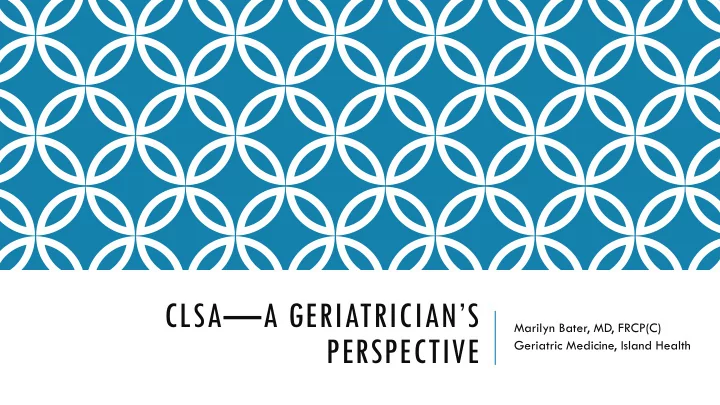

CLSA—A GERIATRICIAN’S Marilyn Bater, MD, FRCP(C) PERSPECTIVE Geriatric Medicine, Island Health
Medical FRAILTY, FALLS, FRACTURES Cognitive Affective Frailty Physical Functional Cognitive Advance Social Support Directives Status Emotional Social Environmental Spirituality Economic
FRAILTY Frailty has been recognized as a concept for 30 years Definitions vary A syndrome resulting from a multisystem reduction in reserve capacity to the extent that physiologic systems are close to, or pass, the threshold of symptomatic clinical failure A state of increased vulnerability to adverse outcomes
FRAILTY A clinical syndrome: Weakness Fatigue Inactivity Reduced food intake and weight loss Often associated with: Sarcopenia Balance and gait abnormalities Deconditioning Osteopenia
FRAILTY Reserves • Health • Attitude • Resources • Caregiver Stressors • Illness • Disability • Dependence on others • Burden on caregiver
VULNERABILITY TO STRESSORS
FRAILTY Understanding frailty is important Greater complexity in treatment choices More complex care planning Greater costs of care
FRAILTY Frailty and its precursor state are potentially reversible It is a dynamic process Risk of mortality is better predicted by frailty than by chronological age With chronic disease, the addition of frailty increases mortality
PROACTIVE ATTENTION TO FRAILTY Identify “at-risk” individuals Target resources and strategies to prevent slide into frailty or worsened frailty In the community In the hospital Use frailty as a component to decisions regarding health care investigations, future planning Palliative and Therapeutic Harmonization (PATH)
WHAT ARE WE LOOKING FOR SPECIFICALLY? Cardiovascular wellness Exercise tolerance Any known heart disease Diseases that influence cardiovascular health High blood pressure Diabetes High cholesterol EKG
WHAT ARE WE LOOKING FOR SPECIFICALLY? Cerebrovascular Health High blood pressure Diabetes Heart disease Heart rhythm problems Carotid stenosis—Doppler ultrasound of carotid arteries Stroke Risk
WHAT ARE WE LOOKING FOR SPECIFICALLY? Falls and Fractures Predisposing diseases that are associated with falls Osteopenia Osteoporosis FRAX score—10 year probability of hip fracture or other major osteoporotic fracture
WHY BONE DENSITOMETRY? Identifies reduced bone mineral density and stratifies risk of fracture Radiation exposure is equivalent to one day of background radiation
OTHER RISKS FOR FRACTURE Advanced age Previous fractures Falls Glucocorticoid therapy Family history of hip fracture Smoking/Alcohol Diseases—Rheumatoid arthritis, liver disease, malabsorption, premature menopause, inflammatory bowel disease
WHY WORRY ABOUT FALLS AND FRACTURES? Fractures of vertebrae and hip cause: Chronic pain Deformity Depression Disability Death 50% of individual with hip fracture are UNABLE to walk without assistance 25% require residential care
Thank You Very Much! Marilyn.Bater@viha.ca Stand for people. Not a product or service or metric or number. Stand for real, living, breathing people and we will change the world.
Recommend
More recommend